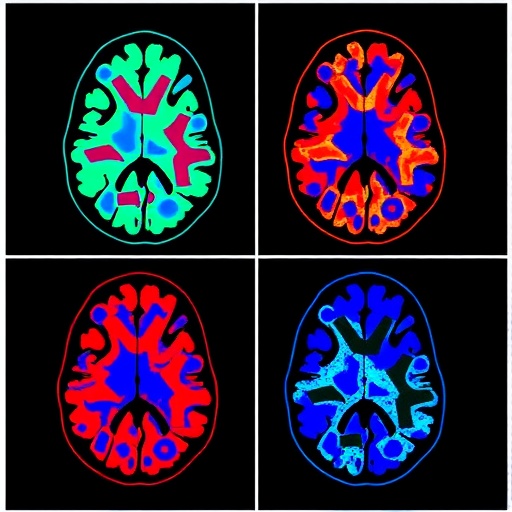In recent years, the understanding and treatment of Alzheimer’s disease, specifically its earlier stages, have gained considerable attention within the scientific community. Recent advances have illuminated the complex interplay of neuroimaging modalities and omics technologies, which include genomics, proteomics, and metabolomics, to develop a clearer picture of mild cognitive impairment (MCI). The study conducted by Afxenti, Zachariou, Athieniti, and colleagues highlights groundbreaking approaches in the integration of these advanced methodologies, thereby enhancing the subcategorization and understanding of MCI linked to Alzheimer’s disease.
Alzheimer’s disease remains one of the most challenging neurological disorders faced globally, affecting millions of individuals and burdening families and healthcare systems. MCI is seen as a pivotal stage, often serving as a precursor to Alzheimer’s disease. Early detection and accurate diagnosis stand as key elements in managing progression and providing interventions tailored to individual patients. However, traditional diagnostic methods often fall short due to their limitations in sensitivity and specificity. The innovative approaches delineated in the recent research provide substantial progress toward overcoming these hurdles.
The integration of imaging techniques with omics is particularly promising. Imaging technologies such as MRI and PET scans allow researchers to visualize structural and functional changes in the brain, offering insights into neuronal degeneration and amyloid deposition. Meanwhile, omics technology facilitates a comprehensive analysis at molecular levels, revealing biochemical alterations that can signal disease pathology. This dual approach seeks to unravel the complexities of Alzheimer’s disease, enabling clinicians to develop a multifaceted diagnostic framework that surpasses conventional methods.
A key component of Afxenti’s study is the emphasis on creating specific subtypes of MCI. By categorizing patients more accurately, healthcare professionals can tailor their treatment strategies and potentially delay the onset of Alzheimer’s. For example, omics data may show distinct metabolic profiles in patients who will benefit from certain therapies compared to others. Conversely, imaging can highlight unique structural brain patterns that correlate with subjective cognitive complaints, enhancing the ability to predict disease progression.
The research also sheds light on the role of biomarkers. Identifying actionable biomarkers within the omics data sets can lead to earlier interventions and more personalized patient care. As the study illustrates, combining biomarker analysis with imaging can significantly refine diagnostic accuracy, leading to high-fidelity prognostic insights that are critical for timely and effective treatment plans.
This multidisciplinary approach emphasizes the importance of collaboration among researchers from various scientific backgrounds. By synthesizing expertise from neuroimaging, molecular biology, and clinical neuropsychology, researchers can forge new pathways in understanding Alzheimer’s disease. This collaboration can innovate therapeutic targets, informing drug development strategies that align with specific MCI profiles and biological mechanisms.
While the implications of Afxenti and colleagues’ research are profound, obstacles remain. The complexity of integrating large datasets from different modalities necessitates robust analytical frameworks. Furthermore, ensuring reproducibility and validation of biomarkers across wider populations is crucial. The study suggests a pathway forward but recognizes the need for ongoing research to confirm these findings and optimize methodologies.
As the research community delves deeper into these advanced technologies, it is essential to convey findings and encourage public engagement. Alzheimer’s disease affects everyone, from families grappling with its effects to policymakers striving to allocate resources effectively. Raising awareness and understanding of how these new diagnostic approaches can alter the landscape of Alzheimer’s management is vital for garnering support for further research and innovation.
In conclusion, the integration of imaging and omics in the study of mild cognitive impairment offers powerful insights and has the potential to revolutionize how we diagnose and treat Alzheimer’s disease. The work of Afxenti, Zachariou, Athieniti, and their team is paving the way for a new era in neurodegenerative research, one that promises not only to improve diagnostic practices but also to create targeted therapeutic avenues that can significantly enhance the quality of life for individuals at risk of or suffering from Alzheimer’s disease.
The study’s contributions are vital for understanding the biological underpinnings of MCI and its progression to Alzheimer’s. With continued research and innovative approaches in merging different scientific disciplines, the future of Alzheimer’s diagnosis and treatment appears increasingly promising. As we stand on the cusp of these advancements, the hope for a more reliable and effective approach to combatting this insidious disease grows brighter.
The exploration of new modalities, coupled with modern technologies, holds immense potential for future breakthroughs in the treatment of Alzheimer’s. As this field continues to evolve, it is crucial for researchers, medical practitioners, and the general public to remain informed and engaged, ensuring that the challenges posed by Alzheimer’s are met with relentless innovation and compassionate care.
Subject of Research: Integrating imaging and omics for enhanced subtyping of mild cognitive impairment associated with Alzheimer’s disease
Article Title: Integrating imaging and omics for enhanced subtyping of mild cognitive impairment associated with Alzheimer’s disease
Article References: Afxenti, S., Zachariou, M., Athieniti, E. et al. Integrating imaging and omics for enhanced subtyping of mild cognitive impairment associated with Alzheimer’s disease. J Transl Med 23, 1240 (2025). https://doi.org/10.1186/s12967-025-06937-x
Image Credits: AI Generated
DOI: https://doi.org/10.1186/s12967-025-06937-x
Keywords: Alzheimer’s disease, MCI, imaging, omics, biomarkers, neurodegeneration, personalized medicine




